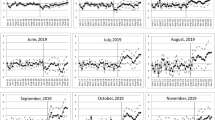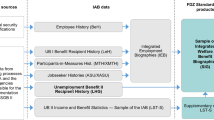Abstract
India’s National Rural Employment Guarantee Scheme (NREGS) has been hailed as one of the country’s most creative social initiatives. Since the program was begun only recently (in 2004–2005) there is a need to assess household access to this program and persistence of benefits to households not just in one year but over time. Using a unique panel data set for 2007–2008 and 2009–2010 for the Indian state of Rajasthan, this paper analyzes the transitions into and out of NREGS. It models the impact of such transitions on earnings of workers as well the determinants of such transitions. To the best of our knowledge this is the first study of this kind. Several policy conclusions are advanced.
Abstract
Le Programme Nationale pour la Garantie de l’Emploi Rurale, en Inde (NREGS) a été acclame comme une des initiatives sociales plus créatives du pays. Puisque le programme est assez récente (il a débuté en 2004–2005) il faut évaluer l’accès des ménages au programme, et la longévité des bénéfices qu’ils en reçoivent, pendant plusieurs années. Cet étude analyse les ménages qui entrent et sortent du NREGS, utilisant une base de données couvrant l’état Indien du Rajasthan pendant les années 2007–2008 et 2009–2010. Cette elude monte les transitions des ménages, aussi que l’impact des transitions sur les salaires des travailleurs. Anotre connaissance, c’est le premier étude de ce type. Plusieurs recommandations en matière de politique sont avancées.

Similar content being viewed by others
Notes
For an analysis of NREGS benefits in an empowerment framework, see Shankar and Gaiha (2013).
NREGS was implemented only in seven districts of Rajasthan in 2007–2008 but this number increased subsequently.
As the magnitude of attrition was small and the pattern random, no further comment is necessary.
A household is said to be an NREGS participating household if at least one of its members worked for some time under NREGS in the last 365 days. Although we collected data on NREGS card holders, we did not use the data for validation because of glaring mismatch between the card holders and participants – especially the fact that only a fraction of the former participated in this scheme (Khera, 2011). Therefore, our estimates of NREGS participants are based on household member responses.
A household is said to be a PDS participating household if it has drawn foodgrain (rice or wheat) or sugar or kerosene from PDS.
State averages are unweighted means and thus differ from all-India averages.
We surmise that food price hikes during 2007–2008 were associated with rise in poverty, especially among net buyers of food.
Whether such changes in poverty status over a short period are plausible requires elaboration. Such changes did occur in the past over a period of just 3 years in the initial phase of the Green Revolution in India (Gaiha, 1987, 1988). The period 2007–2009 was marked by the emergence of a land market and rising land values due to the food price spiral. These changes to a large extent offset the effects of a drought in 2009, with landowners and net sellers of food benefiting and landless and net buyers of food losing. We are grateful to an anonymous reviewer for raising this issue.
As noted in the previous footnote, this reflects emergence of a land market and rising land values due to sharp food price spikes in 2007–2008.
It is unclear why there was a large reduction in the proportion of affluent households.
This classification is specific to the period covered by the panel data set. We owe this clarification to an anonymous reviewer.
To avoid cluttering the text with numbers, we summarize here the findings from stochastic dominance tests (graphs available on request). Consider Type IV households first. Both proportions of acutely poor and moderately poor were higher in 2009–2010 than in 2007–2008, especially the former. In sharp contrast, among Type I households, proportions of acutely and moderately poor were only slightly higher. More on these tests later.
This tests the equality of matched pairs of observations by using the Wilcoxon matched-pairs signed-ranks test (Wilcoxon, 1945). The null hypothesis under Wilcoxon signed-rank test is that distributions for both the years 2007–2008 and 2009–2010 are the same.
This tests the equality of matched pairs of observations. The null hypothesis is that the median of the differences is zero.
The test enables ordinal poverty comparisons for a range of poverty thresholds and the FGT class of poverty indices.
These details are not reported here but are available upon request.
Repetition of net of NREGS earnings is omitted to enhance readability.
We are grateful to two anonymous reviewers for raising this issue.
These results point to the importance of economic incentives in choosing NREGS, contrary to the view of Besley and Coate (1992) that public support in the form of workfare causes the poor to depend on it and neglect job search and other employment options. For an earlier critique, see Gaiha (1996).
For further details, see Shankar and Gaiha (2013).
References
Abdulai, A. and Aubert, D. (2004) A cross-section analysis of household demand for food and nutrients in Tanzania. Agricultural Economics 31 (1): 67–79.
Atkinson, A.B. (1987) On the measurement of poverty. Econometrica 55 (3): 749–64.
Besley, T. and Coate, S. (1992) Workfare versus welfare: Incentive arguments for work requirements in poverty alleviation. American Economic Review 82 (1): 249–261.
Ecker, O. and Qaim, M. (2008) Income and Price Elasticities of Food Demand and Nutrient Consumption in Malawi. 2008 Annual Meeting, 27–29 July. Orlando, FL: American Agricultural Economics Association.
Gaiha, R. (1987) Impoverishment, technology and growth in rural India. Cambridge Journal of Economics 11 (1): 23–46.
Gaiha, R. (1988) Income mobility in rural India. Economic Development and Cultural Change 36 (2): 279–302.
Gaiha, R. (1996) How dependent are the rural poor on the employment guarantee scheme in India? Journal of Development Studies 32 (5): 669–694.
Government of India (2012) Ministry of Rural Development ‘Report to the People’. http://nrega.nic.in/circular/People_Report.html, accessed 26 July 2012.
Greene, W.H (2003) Econometric Analysis, 5th edn. Delhi, India: Pearson Education.
Jha, R. and Gaiha, R. (2012) NREGS: Interpreting the official statistics. Economic & Political Weekly 42 (18): 18–22.
Jha, R., Gaiha, R., Shankar, S. and Pandey, M. (2012) Targeting accuracy of the NREG: Evidence from Madhya Pradesh and Tamilnadu. European Journal of Development Research 25 (5): 758–777.
Jha, R., Bhattacharyya, S. and Gaiha, R. (2011) Social safety nets and nutrient deprivation: An analysis of the National Rural Employment Guarantee program and the public distribution system in India. Journal of Asian Economics 22: 189–201.
Khera, R. (2011) The Battle for Employment Guarantee. New Delhi, India: Oxford University Press.
Shankar, S. and Gaiha, R. (2013) Battling Corruption: Has NREGA Reached India’s Rural Poor?. New Delhi, India: Oxford University Press.
Wilcoxon, F. (1945) Individual comparisons by ranking methods. Biometrics 1: 80–83.
Acknowledgements
We gratefully acknowledge financial support from Australian Research Council-AusAID Linkage grant LP077544 for financial support. We are grateful to the anonymous referees for helpful comments, the editor for encouragement and Raj Bhatia for expert statistical assistance. The usual caveat applies.
Author information
Authors and Affiliations
Rights and permissions
About this article
Cite this article
Jha, R., Gaiha, R., Pandey, M. et al. Determinants and Persistence of Benefits from the National Rural Employment Guarantee Scheme – Panel Data Analysis for Rajasthan, India. Eur J Dev Res 27, 308–329 (2015). https://doi.org/10.1057/ejdr.2014.37
Published:
Issue Date:
DOI: https://doi.org/10.1057/ejdr.2014.37




